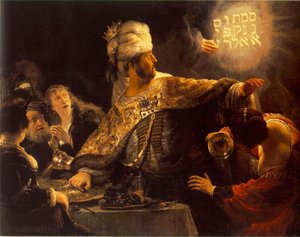I-MAG STS Corporation
Rembrandt Harmensz van Rijn (Dutch 1606-69) painted Belshazzar's
Feast in 1665. The source of inspiration was the Old Testament Book
of Daniel chapter 5. In the middle of a feast Belshazzar, then king of
Babylon, and his guests witness a disembodied hand writing on the
wall. In the painting, the artist shifted the four words "mene, mene
tikhil upharsin" from Aramaic to Hebrew, mis-transcribed one
characters and arranged the text in columns. 2500 years ago, Aramaic
was the C language of its time, and was for centuries the official
language of the Assyrian, Babylonian and Persian empires, among
others. Daniel interpreted the words, which referred to measures of
grain, as the king had been measured and found wanting. According to
legend, Belshazzar lost his life and his kingdom that night.
Feast in 1665. The source of inspiration was the Old Testament Book
of Daniel chapter 5. In the middle of a feast Belshazzar, then king of
Babylon, and his guests witness a disembodied hand writing on the
wall. In the painting, the artist shifted the four words "mene, mene
tikhil upharsin" from Aramaic to Hebrew, mis-transcribed one
characters and arranged the text in columns. 2500 years ago, Aramaic
was the C language of its time, and was for centuries the official
language of the Assyrian, Babylonian and Persian empires, among
others. Daniel interpreted the words, which referred to measures of
grain, as the king had been measured and found wanting. According to
legend, Belshazzar lost his life and his kingdom that night.

Courtesy to the United States Geological Survey databases, the area around Nias has had more than 2500 seismic events - a
veritable Belshazzar's feast of earthquakes - since 1973. The commonly available data contains date and time, location (longitude,
latitude and depth) and Richter magnitude. We are unclear how missing magnitudes are to be understood, so we have
temporarily removed 183 records from the calculations. This leaves one 8.7, two 7s, twenty-one 6s, and about 300 5s, 1900 4s and
100 3s. In statistics, as in life, it is often useful to look at one's data in greater depth before plunging into analysis. In the case of
earthquake data, one might wish for some indication of how long the shaking lasted as well as how far along the fault line
movement occurred. For example, the rupture from 2004 event was over 500 kilometers. A series of papers by Gisler, Gittings,
Mader and Weaver showed that tsunamis generated by point events like asteroid impacts and volcano eruptions propagate less
effectively across great distances than extended events such as landslides and earthquakes.
veritable Belshazzar's feast of earthquakes - since 1973. The commonly available data contains date and time, location (longitude,
latitude and depth) and Richter magnitude. We are unclear how missing magnitudes are to be understood, so we have
temporarily removed 183 records from the calculations. This leaves one 8.7, two 7s, twenty-one 6s, and about 300 5s, 1900 4s and
100 3s. In statistics, as in life, it is often useful to look at one's data in greater depth before plunging into analysis. In the case of
earthquake data, one might wish for some indication of how long the shaking lasted as well as how far along the fault line
movement occurred. For example, the rupture from 2004 event was over 500 kilometers. A series of papers by Gisler, Gittings,
Mader and Weaver showed that tsunamis generated by point events like asteroid impacts and volcano eruptions propagate less
effectively across great distances than extended events such as landslides and earthquakes.